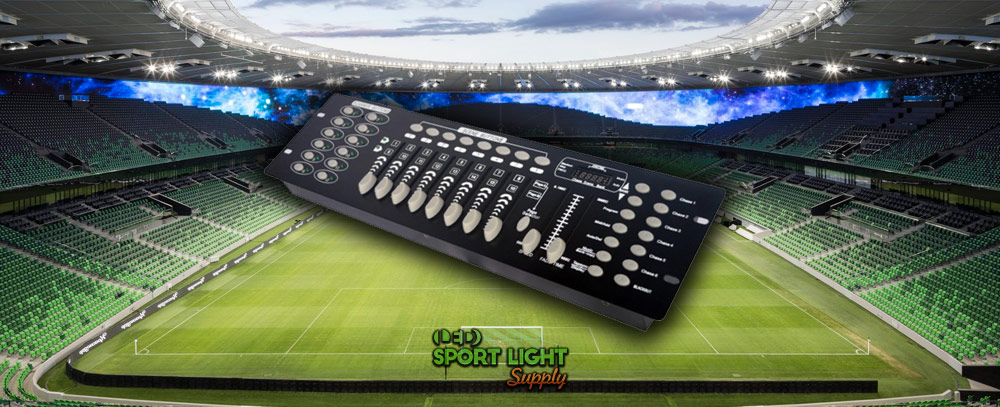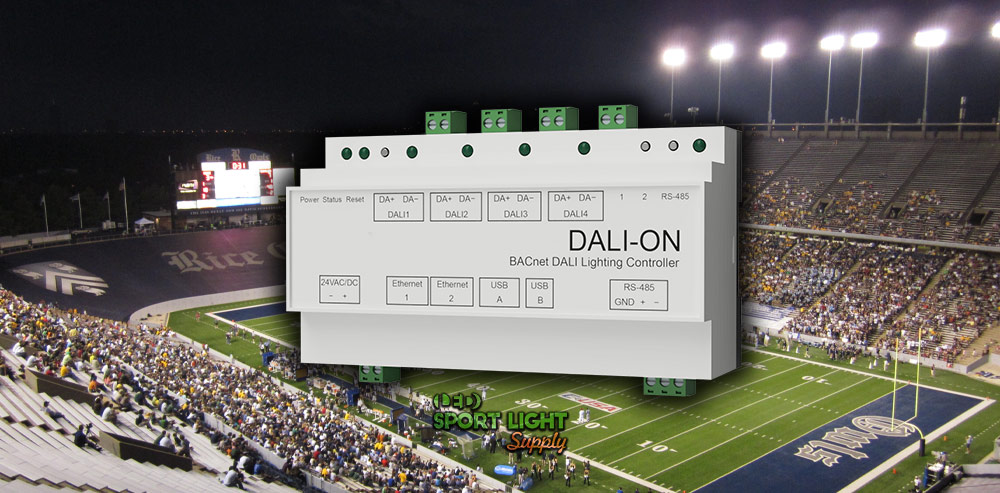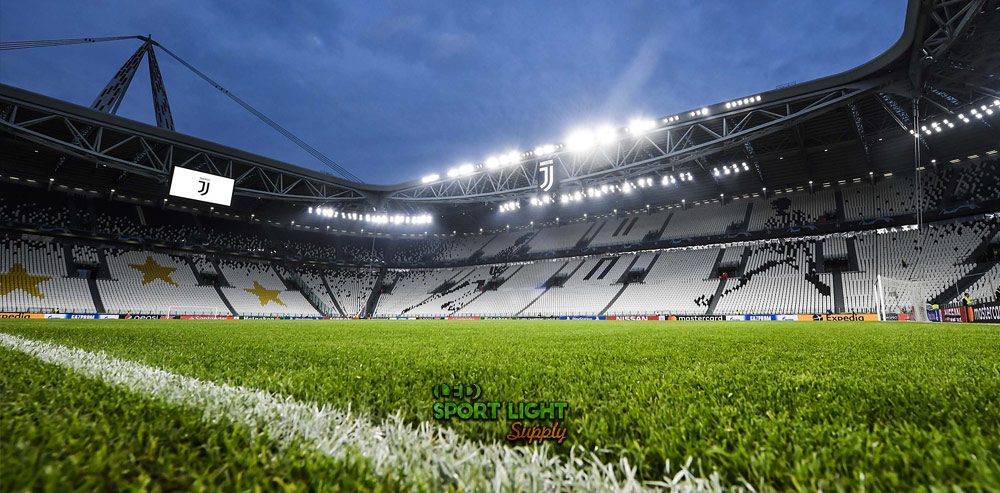Stadium and field lighting systems that utilize LED sports lights require control systems to connect all the lights in use. These systems enhance the professionalism of sports activities and add an element of entertainment that sports fans increasingly appreciate. To achieve this, two types of light controllers are commonly used: DMX and DALI. Each system has its own set of strengths and weaknesses, making it important to understand their differences.
Table of Contents
ToggleUnderstanding DMX
DMX Controller for LED Stadium Lights

The DMX lighting system is highly regarded in the sports world as a top-tier lighting controller. It functions as a centralized control system, capable of managing up to 512 separate light sources, with each channel representing one lamp. This system supports a wired connection that can extend up to 300 meters. To control a large number of lights, such as 512 light sources, drop connectors (RS422 or RS485) are required, enabling the control board to manage more lights efficiently.
One significant advantage of the DMX controller is its ability to control the color of LED lights, provided that RGB-LED light fixtures are used. Floodlights without color control capabilities will not be able to change color, highlighting the importance of using compatible fixtures. The DMX system offers fast control speed, allowing for instantaneous lighting changes, whether you’re bringing up the lights or fading them out. This speed is achieved through digital multiplexing capabilities.
The DMX board is also well-suited for controlling high mast poles and other stadium lights. Due to its capacity to manage a large number of lights, it is ideal for programming spectator lights to create special effects. These effects can include light sparkles, sequenced flashing, and other visual effects that enhance the spectator experience.
Understanding DALI
DALI Sports Lighting Control System

The DALI system offers a more simplified approach to sports lighting control, characterized by its decentralized design, allowing each section of lights to be controlled individually. This system requires hardwiring between control panels, with two wires connecting each control section. The DALI system can manage up to 64 LED light fixtures and offers a total of 254 brightness levels. The controller itself is a slide switchboard, featuring on/off buttons for each slide bank.
Like the DMX system, DALI can also cover a distance of up to 300 meters between connections, but it operates at a slower connection speed. As a result, there may be a slight delay, typically 1-2 seconds, when dimming lights. Despite this, DALI remains a reliable choice for controlling high mast lights, though it is often preferred for off-field lighting. It is also possible to mix and match DALI with field and off-field lights as needed.
Given that each panel controls a specific number of lights, typically no more than two light fixtures are managed between individual control panels. The fading control is executed using a step controller for each fade level, offering a slower but more straightforward system compared to DMX. Since DMX utilizes a CAT-5 cable connection rather than a two-wire system, its reaction time is quicker.
| Feature | DMX Controller | DALI System |
|---|---|---|
| Control Capacity | Up to 512 light sources | Up to 64 light fixtures |
| Distance Covered | Up to 300 meters | Up to 300 meters |
| Required Wiring/Connectors | Drop connectors (RS422 or RS485) | Two wires between control sections |
| Color Control | Yes (with RGB-LED light fixtures) | No |
| Brightness Levels | Not specified | 254 levels |
| Speed | Fast, with instantaneous lighting changes | Slower, with a 1-2 second delay |
| Suitable For | High mast poles, stadium lights, and spectator effects | High mast lights, off-field lighting, and mixed lighting setups |
Similarities Between DMX and DALI
Light Controllers
In any lighting system, a control panel is essential to manage the various light fixtures. For DALI systems, these panels are designed to enable fading control. On the other hand, DMX systems utilize a controller that transmits information back to the main controller. These multifunction control panels are capable of both fading and color control. The DMX system also incorporates specific types of interface controls, such as RS422 or RS485 controllers, to ensure smooth operation.
Distance of Operations
DMX and DALI systems use different types of wiring, but the operational distance is similar. Both systems allow light fixtures to be connected to the main controller over a distance of up to 300 meters. This requires strategic placement of the main control board, ensuring that no fixture is more than 300 meters away. This distance is sufficient for applications such as high mast lighting, where even modern super domes, typically around 210 meters in diameter, can be fully illuminated.
High Mast Lights
High mast lighting systems can be controlled by both DALI and DMX systems. While there are differences in wiring and operating speed, both systems are effective for high mast applications. In a DALI system, two light fixtures can be controlled by a single control unit. Conversely, the DMX system requires a separate interface controller for each light bank, providing flexibility and precision in managing large-scale lighting installations.
Off-Field Lights
Off-field lighting, such as spectator lights and other stadium-related areas, can be managed by both DALI and DMX systems. These lights often include fading controls, allowing for reduced illumination levels where needed, such as in walkways and staircases, while still providing sufficient visibility. Additionally, these systems can be used to create special lighting effects, such as raising the house lights to celebrate team goals or scores, enhancing the overall experience for spectators.
Differences between DMX and DALI
Color Control
The DMX system offers advanced color control, allowing the manipulation of lighting colors through specialized LED lamps, particularly RGB-LEDs. This feature is particularly useful for creating dynamic visual effects, though it may not always be ideal for field lighting. The DMX system is capable of directing light towards both spectators and the field, providing a versatile lighting solution. In contrast, the DALI control system is limited to basic dimming functions and cannot support color-changing lights, as it was originally designed for simple fader operations.
Speed Control
When it comes to speed, the DMX controller stands out for its fast-speed interface, capable of delivering real-time information from the fixture. The type of wiring used in DMX systems allows for rapid communication, enabling on-the-fly lighting adjustments. On the other hand, the DALI system uses a two-wire setup, which introduces a slight delay of up to 2 seconds. While this delay does not significantly affect dimming control, it can be a factor to consider in situations requiring immediate lighting adjustments.
Dimming
Dimming control differs between the two systems. The DALI system offers straightforward dimming through a simple slide control and an on/off switch. It also features a warning indicator that alerts users when a light has failed, making it a user-friendly option for basic dimming tasks. The DMX system, while offering similar dimming capabilities, includes additional features such as delays, special effects, and preprogrammed time fades. However, it does not have a built-in warning indicator, which can be a drawback for those requiring constant monitoring of light functionality.
Controller Design
The controllers for DMX and DALI systems are distinctly different in design and functionality. The DALI controller is a black box with slide controls and an on/off button, reflecting its focus on simplicity. The DMX controller, however, is more complex, featuring not only slide controls but also preset buttons for various lighting effects and color adjustments. The DMX controller is designed for more intricate lighting setups, offering a wide range of preset patterns and effects that can transform the atmosphere of an event.
Number of Lights
One of the most significant differences between DMX and DALI systems is the number of lights they can control. The DMX system can manage up to 512 individual lights or fixtures, making it ideal for large-scale lighting setups, especially in environments where decorative effects and color changes are desired. In contrast, the DALI system can control up to 64 lights, which is sufficient for field lighting but may not be adequate for more complex installations. The DMX system’s ability to handle a larger number of lights makes it a preferred choice for events requiring dynamic lighting effects.
Warning Indicator Lights
The DALI system is equipped with a smart design feature that provides immediate warning when a light bank is not responding, whether due to a malfunctioning light or a problem with the dimming controller. This built-in feature allows for quick identification and resolution of issues, minimizing downtime. The DMX system, while capable of real-time updates on light functionality, does not include a specific warning indicator, which could be a limitation in certain scenarios.
Wiring Differences
The wiring used in DMX and DALI systems also differs significantly. The DMX system utilizes a CAT-5 cable, which ensures fast and direct communication between the controller and the LED fixtures. This allows for simultaneous adjustments to be made as the control panel switches are operated, providing a highly responsive lighting setup. The DALI system, on the other hand, uses a simpler two-wire connection, which results in a longer time for signals to reach the main controller, potentially affecting the responsiveness of the lighting system.
Effect Control
When it comes to creating impressive visual effects, the DMX controller is the clear winner. It offers a wide range of preset effects that can turn any event into a spectacular light show. The DMX system’s ability to combine color-changing LEDs with dynamic lighting effects makes it an excellent choice for enhancing the atmosphere of sports events, concerts, and other large-scale gatherings. The system can also be synchronized with music to amplify key moments, making it a powerful tool for creating an unforgettable experience.

Why DMX or DALI is Popular for Stadium Lighting
Stadiums adopted DMX and DALI light controllers, which were originally common in theater stage lighting, due to their ability to manage complex lighting requirements, such as increasing or fading sports lighting. The DMX controller, in particular, has become more popular because of its multifunctional capabilities. It not only provides the basic functions of lighting control but also offers the ability to incorporate color, which enhances the visual experience during outdoor arena games. Spectators today expect more than just the game itself; they appreciate the added effects that dynamic lighting can provide, making events more engaging and memorable.
The trend of using advanced lighting effects in public displays has naturally extended to sports stadiums. Just as fireworks add excitement to certain baseball games, modern stadium lighting can turn a football or cricket match into a more fan-centric event. For outdoor sports like tennis, the lighting can be adjusted to create a dramatic yet festive atmosphere. These lighting effects can be tailored to celebrate the colors of competing teams or to mark special occasions, adding a layer of entertainment that keeps fans coming back for more.
DMX vs. DALI: Which is Better for Sports Fields?
The choice between DMX and DALI lighting systems for sports fields depends on the specific needs of the venue and the type of sport being played. Both systems are capable of controlling sports lights effectively, but they offer different advantages.
The DMX system has a slight edge in terms of speed, allowing for real-time adjustments and immediate responses to changes in the lighting setup. This is particularly beneficial when color effects are used to enhance the spectator experience. The DMX system also comes with a variety of preset effects that can make the lighting more exciting and visually stimulating for the audience. These features make DMX the preferred choice for larger stadiums and venues where dynamic lighting plays a significant role in the overall event experience.
On the other hand, the DALI system is known for its ease of use. It doesn’t require extensive training, making it a more straightforward option for smaller venues or for situations where basic lighting control is sufficient. While it may lack some of the advanced features of DMX, DALI still offers reliable dimming and control, which can be ideal for more intimate settings or sports fields where simplicity is key.
When comparing DMX and DALI side by side, DMX tends to be the better choice for both small and large venues, especially when color and entertainment are important factors. The DMX system’s versatility allows it to handle complex lighting scenarios, making it an all-in-one solution for venues looking to combine lighting control with enhanced spectator engagement. However, for smaller venues where simplicity and ease of use are more important, DALI remains a satisfying and straightforward choice.
Things to Consider When Selecting a DALI or DMX Light System
Installation Lead Time
When installing either a DALI or DMX light system, the expertise of a qualified electrician is essential. The wiring must be carefully planned, ensuring that it remains within 300 meters of the main controller to function correctly. This process includes the installation of the fader control, which is crucial for achieving proper fading effects with LED lights. If you opt for a DMX system, the CAT-5 wiring interface requires specialized connectors for cable splices. The time needed to connect all the lights properly can be significant, as each light must be meticulously wired and tested.
Both DMX and DALI systems offer technical support for the necessary components, ensuring that the installation process proceeds smoothly.
Type of Color-Changing Lights
The DMX system is unique in its ability to control color-changing LED lights, making it a popular choice for stadiums looking to enhance their lighting capabilities. However, it is essential to determine which type of RGB-LED lights will best suit your needs, whether they be floodlights, spotlights, or a combination of both. The DMX system supports up to 170 fixtures (with 3 channels per RGB lamp), providing ample room for future expansion. These lights are capable of mixing three colors to produce virtually any shade, allowing for a wide range of creative lighting effects.
It is important to note that DMX systems cannot control the light temperature (measured in Kelvin), as this is a feature specific to sports lights.
The Amount of Wiring Involved
Wiring is a critical aspect of installing a stadium lighting system, and it often requires more wiring than initially anticipated. Each light must be tested individually to ensure proper electrical connections, which is where much of the installation lead time is spent. The DALI system, which uses a two-wire connection for each fixture, also requires careful installation to ensure that everything functions as intended. A skilled stadium electrician will be able to manage the complexities of the wiring process, ensuring that the system is installed correctly and efficiently.
The Cost of Adding More Lights
Investing in sports lighting is a significant financial commitment, but it is one that can yield substantial long-term returns. LED lighting, in particular, offers a compelling return on investment, with an estimated lifespan of over 20 years without failure. While the initial costs of building a sports stadium are high, the savings from using LED sports lights can be substantial, with potential savings of 75-85% over the long term. This makes the decision to invest in a high-quality lighting system both cost-effective and financially prudent for the longevity of the stadium.
Conclusion
Choosing between DMX and DALI for stadium lighting depends on your venue’s needs. DMX is ideal for large venues requiring dynamic effects and color control, offering rapid response and extensive customization. DALI, with its simpler setup and ease of use, suits smaller venues or basic lighting needs. Both systems enhance the sports experience, but the right choice depends on the scale and complexity of your lighting requirements.
